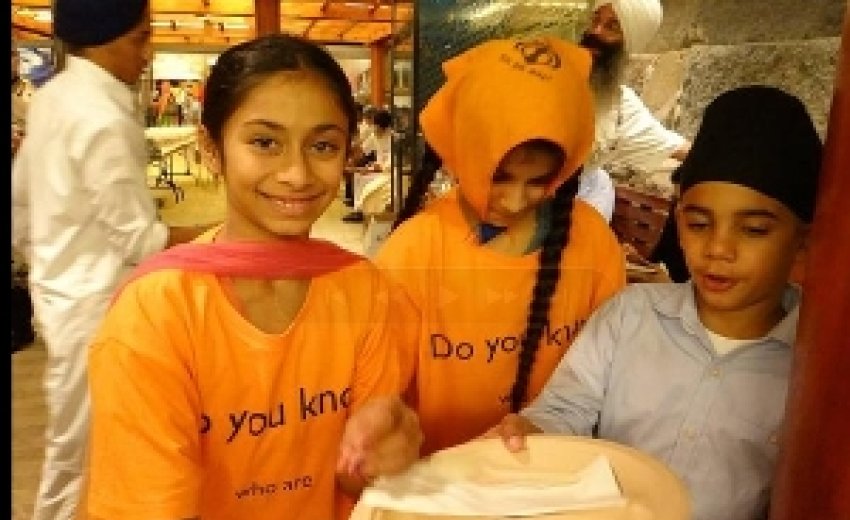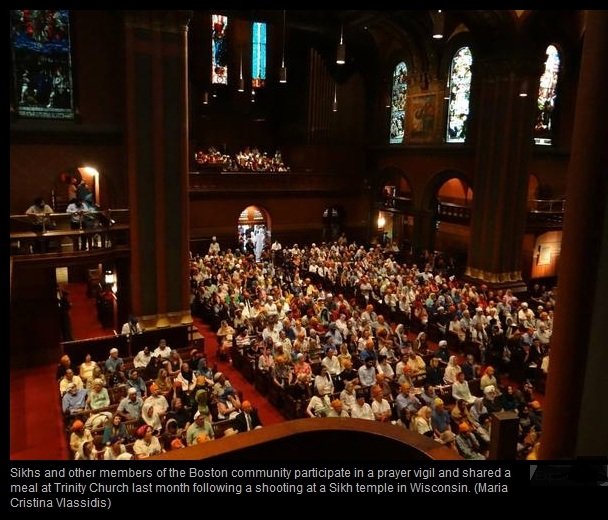 | |
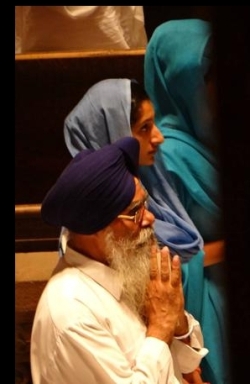 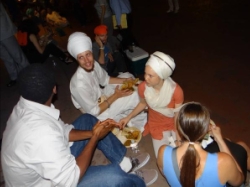 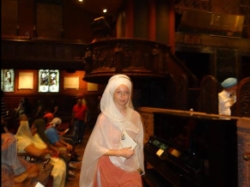 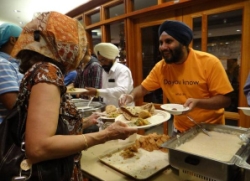 Sikhs and other members of the Boston community participate in a prayer vigil and shared a meal at Trinity Church last month following a shooting at a Sikh temple in Wisconsin. Maria Cristina Vlassidis 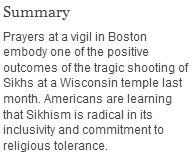 |
Monday, Sept. 17 2012: BOSTON — Dressed in a white flowing robe and donning the traditional Sikh turban and long beard, Bhai Resham Singh, the leader of a Sikh gurdwara in the Boston area, stands before some 1,500 Christians, Jews, Muslims, Sikhs and even atheists. “(We) ask for mercy on the soul of Wade Michael Page, the perpetrator of the massacre,” he says. Though this prayer vigil is taking place in a very Christian space — summer evening light illuminates the Trinity Church’s stained glass windows depicting scenes from the Bible — the service is an education on Sikh worship and beliefs. Non-Sikh participants cover their heads with orange scarves to demonstrate unity with their fellow Sikh worshippers, who wear head coverings to show respect to God. It’s been only a few weeks since the mass shooting at a Sikh house of worship in Oak Creek, Wis., and feelings are still raw as Singh explains that the major tenet of Sikhism is a belief in the equality of all humans, united as children of God. Sikhs, therefore, don’t just pray for their own communities. “We ask for blessings upon all mankind,” he says. And on this humid summer evening, this group of Sikhs puts its prayers where its beliefs are, offering prayers for fellow believers who were killed, police officers who risked their lives to end the bloodshed and even the attacker. “That is the ethos of Sikhism,” Singh continues. “We absolutely believe that as we gather to pray for the souls of the innocents who died, it’s equally important for us to pray that those tormented with hate (who) brought us all together … that they find peace as well.” Singh’s prayer in Boston — perhaps surprising in its unwavering commitment to forgiveness — embodies one of the positive outcomes of the tragedy at Oak Creek. Americans are learning that Sikhism, perhaps more than other world faiths that preach some level of exclusivity, is radical in its inclusivity. In this way, Sikhs also believe that their tradition is in sync with the American ideal of religious pluralism, a pluralism that insists on extending the understanding of the American community to include people of all faith traditions, and people of no faith at all. This means that Page’s act of violence, intended to harm, may in fact have strengthened the Sikh community by providing a platform for building understanding of its mission of tolerance. Sikhism’s (most often pronounced “Sick”-ism) commitment to inclusivity comes directly out of its origins in the 15th-century Punjab region of India, an area rife with religious conflict among Hindus and Muslims. According to Boston University religion professor Stephen Prothero, in response to this religious turmoil, Guru Nanak, the founder of Sikhism, taught that in God’s eyes, “There is no Hindu and no Muslim, so whose path shall I follow? I shall follow the path of God.” Today there are more than 24 million Sikhs (which means “learner” or “student”), making Sikhism the fifth largest world religion. While most still live in the Punjab, Sikhs are spread across every continent on the planet — there are even Sikh scientists who regularly visit Antarctica. There are around 500,000 Sikhs in the United States, mostly concentrated in the cities on America’s east and west coasts. With its history of rejection of religious intolerance, it is perhaps surprising that Sikhism entered the American consciousness after the most dramatic act of religious hate in recent memory: the terrorist attacks of 9/11. Most men, along with many women, cover their uncut hair in a turban called the “dashteer.” It is this practice that led many Americans to confuse Sikhs with the turban-wearing Muslim fundamentalists behind the 9/11 attacks, making Sikhs targets of anti-Muslim backlash. |
|
But, as Prothero points out, anti-Sikh violence predates 9/11. It has been a part of American religious history since Sikhs first settled on the west coast to work on the railroads and in lumber mills at the end of the 19th century. “When they first came, they were called ‘Hindus’ and lumped together with other Indian immigrants,” Prothero explained. In 1907, claiming that the Indians were taking away jobs from “native” Americans, a mob of several hundred white men attacked the Sikh community in Bellingham, Wash., beating the Sikhs in the streets and ransacking their homes. This ongoing confusion about exactly who Sikhs are and what they stand for has led the Sikh community to take a more active role in protecting its own believers. Modeled in part after organizations like the Anti-Defamation League, which Jewish Americans started in 1913 to fight against anti-Semitism, the Sikh American Legal Defense and Education Fund (SALDEF) was established in 2004 to monitor hate crimes against Sikhs and to make sure law enforcement responds appropriately.
As was the case after 9/11, it has most often been assumed that anti-Sikh violence is the result of “mistaken identity.” In fact, the U.S. Justice Department doesn’t monitor hate crimes specifically committed against Sikh Americans. In the wake of the Oak Creek shootings, the American media took a similar approach to that of the U.S. government, presuming that the Sikhs were attacked by mistake, scrambling to explain what Sikhs are not — namely, Muslims. Yet, while American TV pundits took to the airwaves to explain that “Sikhs are not Muslims,” many Sikhs rejected this approach. Valarie Kaur and Simran Jeet Sing wrote in the Washington Post that such a response “implies that there is a ‘correct’ target, and it further implies that hate violence should rightfully be directed at Muslims. This is absolutely unacceptable.” Who Sikhs are Through organizations like SALDEF, Sikh activists are trying to educate the American public not just about who Sikhs aren’t but also who they are: A people who believe there is one god, and every human, regardless of race, class, gender, and even religion is equal, united together in a universal community of humanity. This sense of universalism extends so far that many Sikhs were quick to offer prayers of forgiveness to the alleged shooter at Oak Creek. Some even insisted that the tally of the massacre should not include only the six Sikhs who were killed but also Page, who was shot multiple times by police officers before turning a gun on himself. Just two days after the shootings, on NPR, Rajdeep Singh, the national director of the Sikh Coalition, echoed this sentiment of unity with and care for all humanity. “Every gurdwara has four doors signifying openness to the entire world,” Singh said. Along with singing hymns and reading scriptures, a key part of Sikh worship is the “Langar” meal. Following each service, Sikhs gather and sit on the floor as a symbol of equality and unity and share a meal of traditional Punjabi Indian food. But Rajdeep Singh explained that the gurdwaras’ “free community kitchen isn’t just designed for the community. The purpose for the kitchen is to provide food to anybody who wishes to visit a Sikh place of worship.” As Rajvir Singh, a dental student at Tufts University in Boston, who participated in service at Trinity Church, explained, this means if Page “had brought an open heart instead of [guns], he could have shared a meal with those he shot instead.” Prothero, who also serves as the faculty advisor to BU’s Sikh student coalition, believes that while the attack at Oak Creek has brought a lot of attention to the American Sikh community, “unfortunately, these stories often repeat themselves, in part because Americans lose interest and forget.” Prothero may be right. At the Trinity service in Boston, there were no TV satellite trucks parked in front of the church, nor were there droves of reporters on hand (The Boston Globe did run a story the morning of the service announcing the event). Trinity’s Senior Associate Rector for Christian Formation, the Rev. Dr. William Rich, is a bit more optimistic the Oak Creek events have led to a fundamental change. “After this, we see Sikhs in our communities,” Rich said. “An attack on one set of believers is an attack on all Americans of faith.” And while the media might not have shown up to the Trinity event, the fact that some 1,500 Bostonians came to the worship service — far exceeding the expectation of the event’s organizers who planned to host just a few hundred worshippers — indicates that Americans of all beliefs, and no belief at all, seem committed to showing support for their Sikh neighbors. Rajvir Singh agrees that perhaps the tragedy at Oak Creek has led to a “Sikh moment” in American history. “Sadly, it takes a tragedy like this to encourage Americans to learn about each other. But what Americans should know is that Sikhism reflects American values. … It is our principle that we respect all paths to God.” | |

